Three days in July that shook America
- Published

In a single week last summer, the deaths of two black men and then five police officers in a series of shootings across three US states left some wondering where the country was heading. One year on, what's changed?
Last week, on 5 July, Sandra Sterling lay awake in her bed nearly the entire night.
"At 1:30 this morning, you'll never know what I went through," she said later.
Before the sun rose on 6 July, Diamond Reynolds also could not sleep.
"The first thing I did was think, 'Phil's not here,'" she said. "Last year we was waking up together around this time."
And in the wee hours of 7 July, Abigail Irizarry, a dispatcher for the Dallas Police Department, was also struggling.
"I woke up early and it was kind of hard seeing everything on the news all over again," she said. "The footage of what happened."
'The nation is at tipping point'
One year ago, in rapid succession, a series of incidents shook three American cities over the course of three days:
On 5 July, 37-year-old Alton Sterling was shot six times while pinned to the ground by two Baton Rouge police officers. Cell phone video capturing the struggle and the moment the officers shot him at close range was viewed by millions.
On 6 July, 32-year-old Philando Castile was shot seven times by a St Anthony Police Department officer during a traffic stop, while his girlfriend Diamond Reynolds and her four-year-old daughter watched. Reynolds livestreamed the immediate aftermath, as bloodstains blossomed across the dying man's T-shirt and the officer screamed at her through the window.
On 7 July, a former army reservist arrived at the tail end of a peaceful demonstration in downtown Dallas - part of a nationwide day of protest over the deaths of Castile and Sterling - and started shooting police officers with a Saiga AK-47. Five were killed, and seven other officers were wounded in the deadliest attack on US law enforcement since 9/11.
After the three events splintered apart into their own individual investigations, memorials, trials, and controversies, it became difficult to remember that they occurred back to back, on a week when it felt as if the nation was on the brink of a race war.
But last week, they were pulled back together as the friends, families and survivors central to each incident dutifully marked the anniversaries, one after the other. Though they did so in vastly different ways, with at times diametrically opposed messages, the three communities were all in mourning. They shared those sleepless nights.
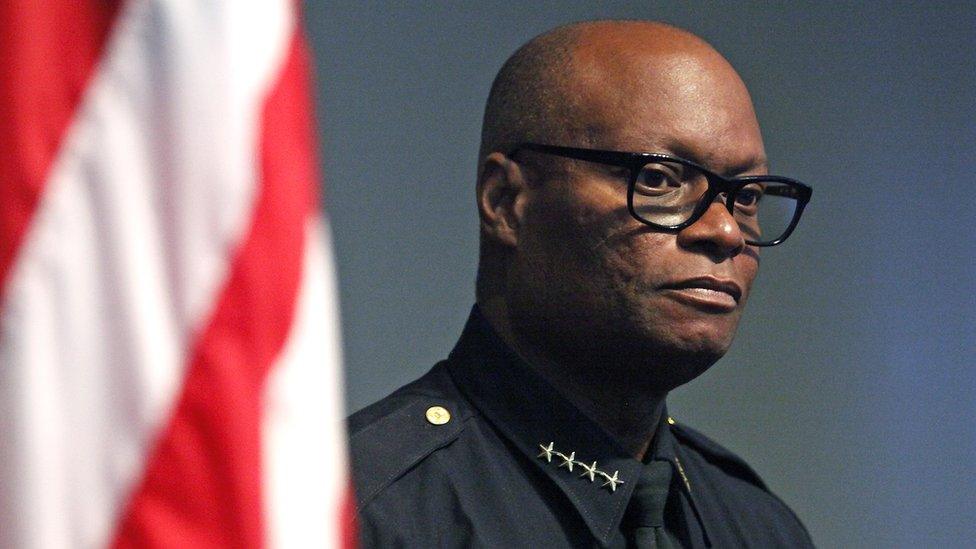
Former Dallas police chief David O Brown
"As much as we politicise and advocate our position when these tragedies happen, the grief of the family of an officer and the grief of the family of a person killed by an officer is the same grief," said David O Brown, who was the chief of the Dallas police on the night of the ambush.
"These funerals - they're all the same," he said. "These families hurt in the same ways."
While the race war never arrived, a new presidential administration did, one with a very different view on the federal government's role in police-involved killings and law enforcement reform in general. President Donald Trump's attorney general, Jeff Sessions, believes that consent decrees - agreements between local police departments and the Department of Justice on a set of reforms that often occur after a high profile incident - can "lower police morale" and actually increase crime.
Sessions has ordered all current consent decrees to be "reviewed". Fourteen police or sheriff's departments currently have such decrees, including Ferguson, Missouri, and many others were in the works in cities like Baltimore and Chicago.
Politics aside, the consequences of these incidents continue to pulse through the nation as a whole, affecting not just the families of the deceased, but those on the periphery as well.
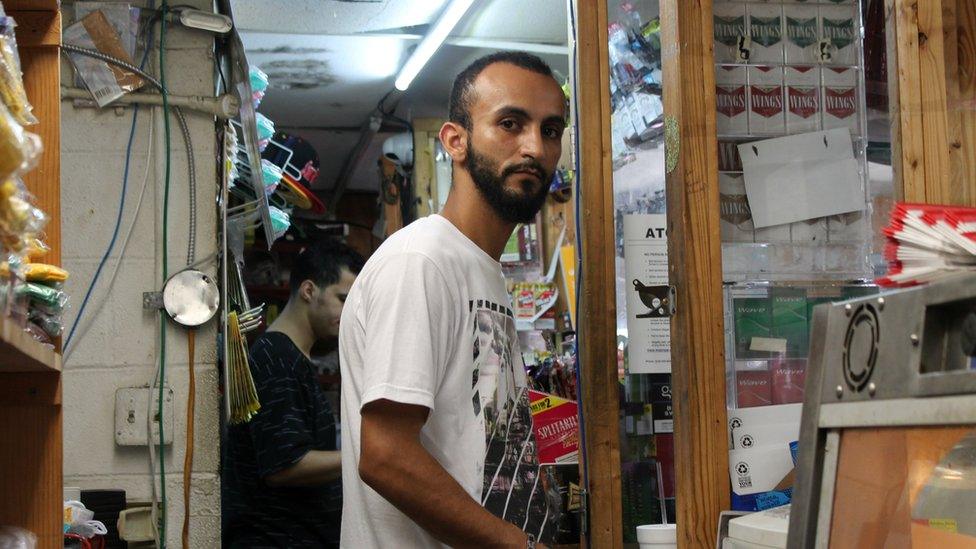
Abdullah Muflahi behind the counter at Triple S Food Mart in Baton Rouge, Louisiana

5 JULY
On the sweltering Baton Rouge afternoon of 5 July, Abdullah Muflahi smoked a cigarette outside of his store, Triple S Convenience, and watched a video on his cell phone.
It was not the one he recorded a year ago, of the death of his friend Alton Sterling, who died just feet from where Muflahi was sitting. It was one from that morning, when a group of protesters from the New Black Panther Party clashed with Baton Rouge police officers at their headquarters a few miles away.
The video, taken by a local news crew, showed the group, external of about 30 demonstrators try to walk through an opening in barricades surrounding the police headquarters when a brawl broke out with the officers blocking the way. The officers deployed their Tasers - they alleged later that one of the Black Panthers also had a Taser - one shot a PepperBall gun at the demonstrators, and seven protesters were arrested.
Two of Sterling's aunts are seen on the tape being dragged to the back of the protest screaming and crying.
"Nothing has changed," said Muflahi. "It's very depressing."

Just a week earlier, US Department of Justice officials declined to charge the two officers who shot Sterling with civil rights violations. Louisiana state officials have yet to announce whether they will pursue their own indictment.
No charges for US police over Alton Sterling killing
Why do US police keep killing black men?
'Legendary' image of US protests emerges
Muflahi, a laconic, bearded 28-year-old Yemeni immigrant, allowed Sterling to sell bootleg CDs on a table outside his shop in a busy but economically depressed part of Baton Rouge. They'd sit outside on days just like this one and talk over cigarettes.
One year ago, Muflahi noticed the flashing lights of police vehicles pull up outside the store. Someone called to say Sterling had threatened them with a gun.
By the time Muflahi pulled out his cell phone and started recording one of two videos that went viral of the incident, Sterling was already on his back with two officers on top of him. Within seconds, one officer yelled, "Gun!" and that's when the shooting started. The video footage shows Sterling's eyes go wide, blood pooling on his chest.
"It's not as easy as just seeing it on the tape or the screen," said Muflahi. "Seeing it in front of you, somebody that you know, you knew for a while, it takes a big effect on your whole life."
Since the incident Muflahi has started seeing a psychiatrist. He said he has trouble sleeping, and when he does sleep, he finds it impossible to get up in the morning.
"My doctor's been trying to give me something to help me out," he said. "He said it was all because of depression."

Arthur "Silky Slim" Reed sits in the back of his "hearse ambulance"
Standing next to Muflahi was Arthur "Silky Slim" Reed, a former gang leader turned activist. Reed runs an organisation called "Stop the Killing" whose members listen to police scanners and race to the scene of every homicide in Baton Rouge. This is how Reed got his hands on the second tape of Sterling's death, which he turned over to the press, not trusting the local police to make it public.
"They have put new policies in place for policing," Reed conceded. "But even when you break the policy there's no [accountability]. So it's the same old thing and it's not just Baton Rouge, it's all over America."
The story behind this photo at Baton Rouge protests
Reed's vehicle sat in the Triple S car park - an ambulance painted black blasting "Tha Crossroads" on a loop. Inside was a bench seat facing a television screen, which played footage of the aftermath of real homicides in Baton Rouge that Reed and his associates filmed, in the hope that showing the extremely graphic tapes to the friends and family of the dead will motivate them to change their lives.
The screen that afternoon showed a young man in a white tank top lying in the street. When the police lifted him by his arms, his head pitched lifelessly to one side, blood pouring out of his nose and mouth.
"So many people like to try to throw this cliche on us like, 'Oh, how come they don't worry about when they killing each other?' We do," said Reed. "We show this."
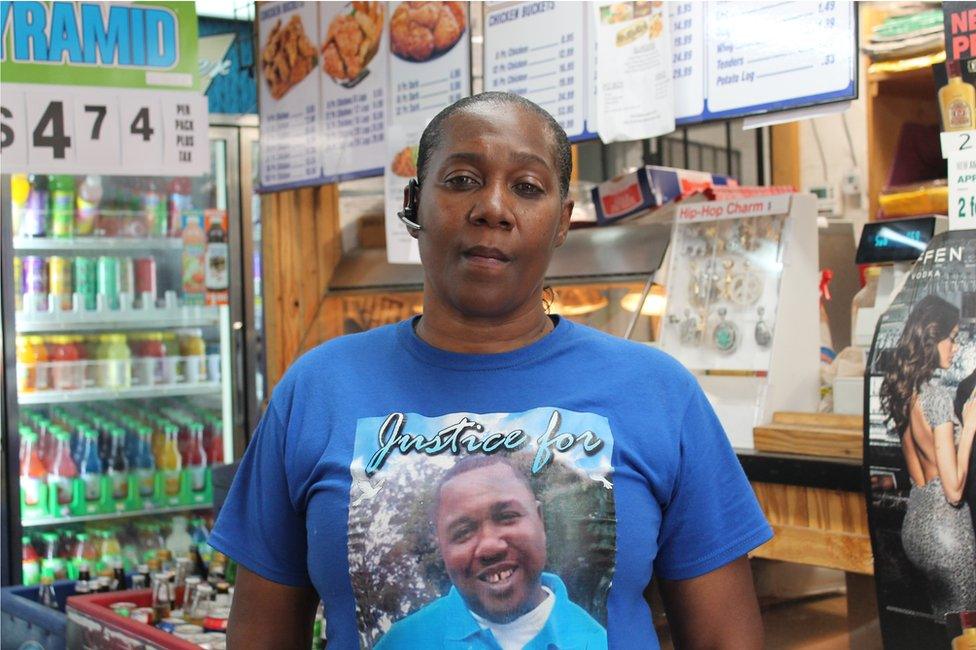
Sandra Sterling at the Triple S Food Market
Not long afterwards, Sandra Sterling - the aunt who raised Alton from the age of 10 when his mother died - walked into the Triple S. She looked exhausted, her voice hoarse from screaming.
"I don't have no strength left," she said.
Sandra said she did her best to raise her sister's children, but Alton and his siblings were often in trouble, sometimes locked up.
During his last stint in prison, Sandra said, Alton's brother died of a drug overdose. When she went to pick Alton up after his release, he insisted she take him straight to his brother's gravesite.
"Later on they buried [Alton] exactly where he was standing," she said.
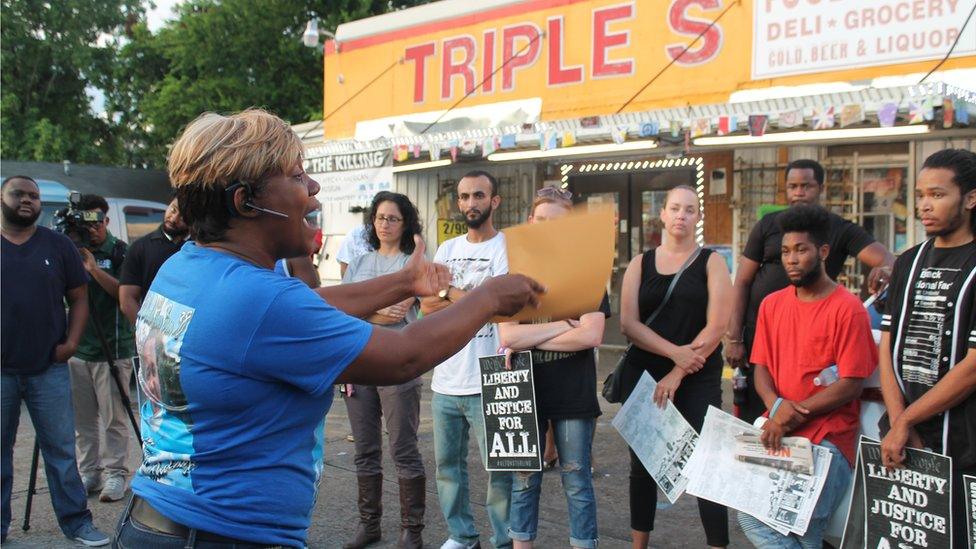
As dusk approached, a group of about 60 activists and community members gathered in the parking lot of the Triple S. It was an informal gathering, light-up placards spelled out the words "JUSTICE FOR ALTON STERLING". A few activists spoke, several state and city officials milled about, but there were no celebrities or crowds like the hundreds that had descended on the food mart a year ago.
Sandra Sterling grew incensed.
"Why nobody out here?" she cried, her voice breaking. "This street was flooded with people. Y'all make me think that y'all forgot about Alton. How could you forget?"
Despite the chants of "justice for Alton Sterling", despite the activist who turned to her and promised in a soaring voice that the two police officers would certainly be indicted, Sandra was not optimistic.
"After the Philando Castile murderer got off, I don't feel a lot of hope," she said.

6 JULY
Unlike the Sterling family, which is still waiting to find out if Louisiana authorities will indict the two officers involved in Alton's death, the friends and family of Philando Castile have their answer. On 17 June, a jury acquitted Officer Jeronimo Yanez on all counts in Castile's death.
On the 6th of July, Diamond Reynolds woke up early, around the time that her boyfriend Castile used to wake up to get ready for his job as a cafeteria supervisor at an elementary school in St Paul, just a few blocks from where he lived as a boy.
Waking up alone, Reynolds said she felt sluggish and weak.
"It's just gonna be a hard day," she said.
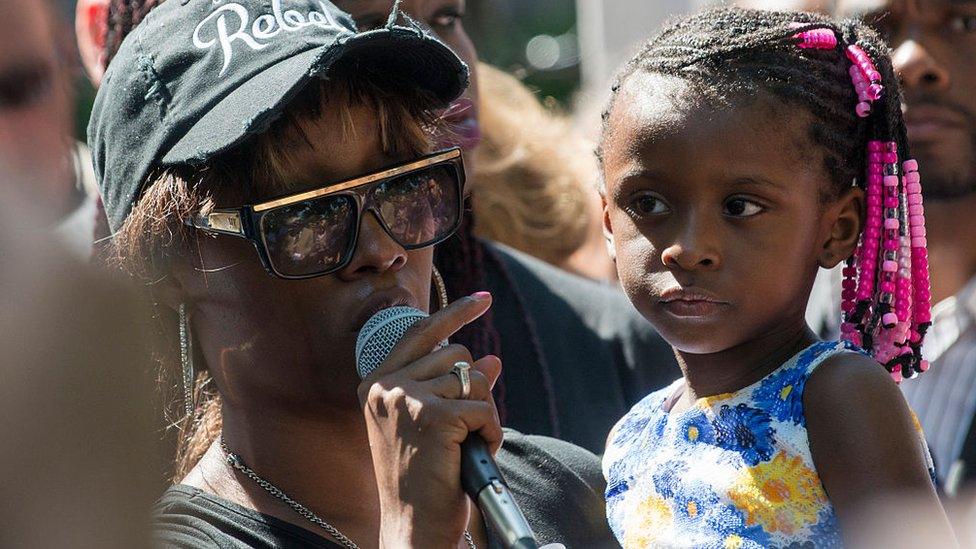
Diamond Reynolds holds her daughter Dae'Anna as she addresses a crowd the day after Castile's death in 2016
Reynolds doesn't have a lot of time for outrage over the court decision. She has to be out of the apartment she and her five-year-old Dae'Anna are currently living in by the end of the month, and since she can't find work, coming up with the money for a new place is proving impossible.
"No one will hire her," said her mother, Dafina Doty. "We're really, really, really having a hard time right now."
Still, Reynolds got up, and loaded Dae'Anna into the car to go do last-minute shopping for an event she was hosting later that afternoon to mark the year anniversary of Castile's death, titled "Black Love: A Remembrance Celebration".
'I don't want you to get shooted': Inside police car after Castile shooting
At about the same time that Reynolds was heading for the store, a press conference was starting at the Minnesota State Capitol in downtown St Paul.
Rather than feeling forgotten in a dusty parking lot like Sandra Sterling had the day before, Castile's uncle Clarence found himself standing beside Minnesota Governor Mark Dayton, who announced the appointment of Clarence to the state's Peace Officer Standards and Training board.
"I can be angry at the system because they let Yanez off the hook. I can be angry at that. But I can also feel empowered because I've been appointed to this board," he said later. "For me, that's power."
Governor Dayton also announced a $12m infusion of money into the board, in a fund named after Philando.
Mark Dayton, Minnesota Governor: "Would this have happened if he was white?"
"We need this extra training for our police officers," Valerie Castile, Philando's mother, told reporters. "Because at the end of the day, everyone wants to go home. The police wants to go home, and the civilian wants to go home."
The Castiles hosted a memorial dinner at an idyllic farm for about 250 friends and family later that day - no media allowed - just to the west of where Philando was killed. Reynolds held her separate event in a lakeside park to the east of the site.
Notably, Castile's name and image were absent from the flier for Reynolds' event. This was in accordance with Castile's mother's wishes, which Reynolds agreed to but was still bothered by.
"The fact that my child wasn't his child and we weren't married doesn't discredit the love that we had for each other," she said. "Doesn't mean we weren't a family."
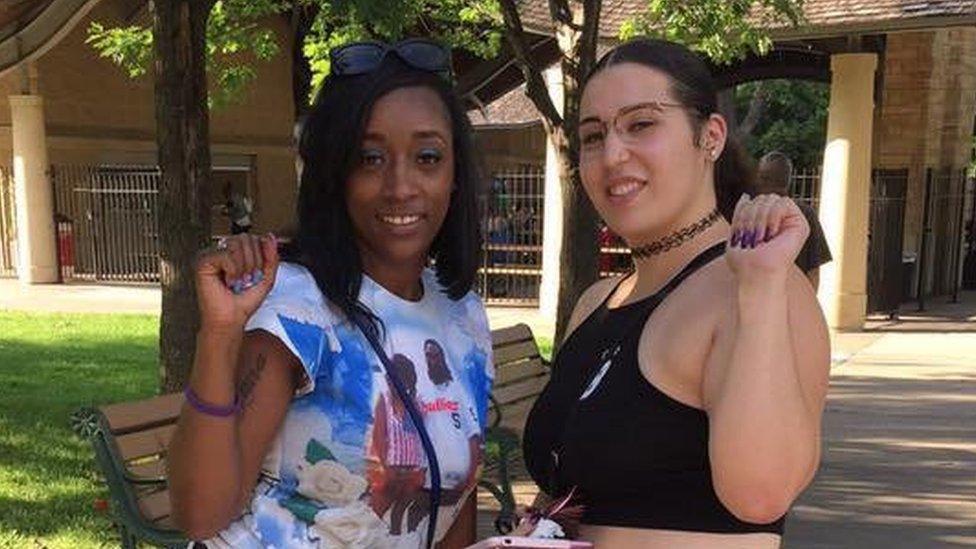
Diamond Reynolds and a friend observe the anniversary of Castile's death at a park in St Paul, Minnesota
At both events, attendees ate and danced, listened to live music. The atmosphere was relaxed, the surroundings were lush. Dae'Anna played with her therapy dog, Chedda - Philando's nickname. Reynolds called it the "closure" that she and her daughter had been craving for the last year.
Still, in the back of Reynolds' mind there are many pressing worries. She rattled off a list of the kinds of jobs she's applied for over the last year: administrative work, customer service, childcare provider, nurse's aid.
"People notice who I am and they don't want to work with me," she said.
Then there's Dae'Anna. Reynolds needs to find a new home in time to enrol her for her first day of elementary school. The five year old is thriving in some ways - already reading chapter books and excited to start the first grade - but she also gets picked on by other kids who needle her about Castile. She's receiving therapy, but still ducks down in her car seat at the sound of sirens.
"She thinks any police officer [could hurt her]," said Reynolds. "Even when I tell her all police officers aren't bad, she's still going to be scared of them."
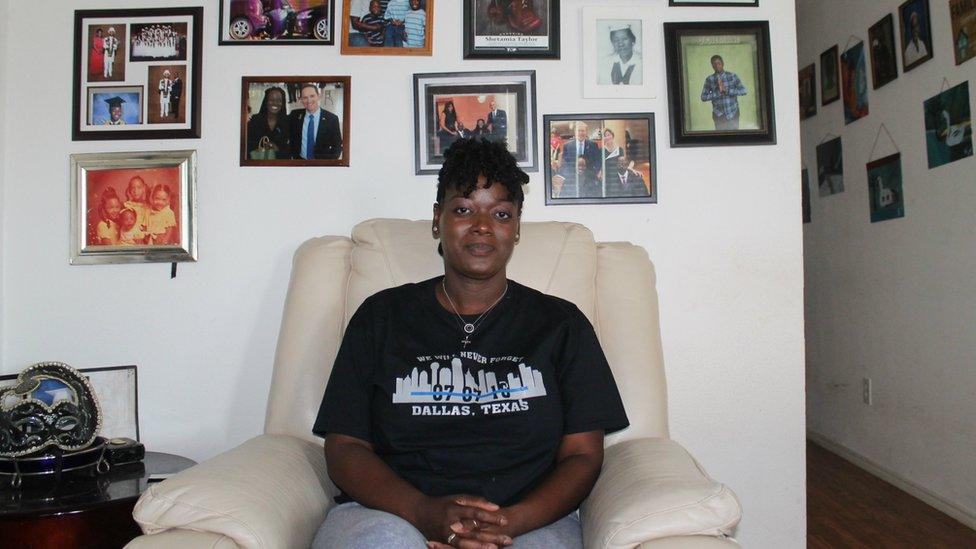
Shetamia Taylor in her family's home

7 JULY
Shetamia Taylor remembers the face of the burly, bald officer who turned as he was being shot and called out to her as she and her four sons were leaving what had been a peaceful protest in downtown Dallas.
"He's got a gun," the officer yelled. "Get down!"
Taylor and her sons turned to run, but before she could, a bullet ripped through her leg with a red-hot stinging sensation, shattering her tibia bone. She grabbed on to her second oldest son and tumbled to the ground, covering him with her body.
A group of officers formed a protective circle around Taylor, including the one who'd first warned her. Later on she learned his name: Dallas police officer Lorne Ahrens. He would not survive.
"He was one of the five," she recalls. "I am so thankful to god that he spared us, but I'm so saddened that these men, these husbands, these fathers didn't."
People in Dallas started running when they hear dozens of gun shots
On 7 July 2017, the city of Dallas commemorated the deaths of Officer Ahrens, Officer Patrick Zamarripa, Officer Michael Krol, Sergeant Michael Smith, and Dallas Area Rapid Transit officer Brent Thompson. All five were killed in an ambush by Micah Xavier Johnson, who reportedly told police negotiators he wanted to kill white officers in retaliation for the deaths of black men and women at the hands of police. Johnson was killed after an hours-long standoff by an explosion set off by the Dallas police.
Dallas police shootings: What we know so far
Who were victims of the Dallas shooting?
In pictures: Dallas police shootings
One year later, in the dim light of the room which served as her recovery room for three months, Taylor still walked with a slight limp. She had a metal plate and six screws holding the bone together, and though she was finally able to return to work she still has thousands of dollars in medical bills left to pay.
She had no plans to venture back into downtown Dallas for memorial events that day. Just seeing the news about the anniversary that morning sent her into a minor panic attack, her chest pounding and hands shaking.
"I guess it's just part of the PTSD," she said.

El Centro College police officer John Abbott was wounded pursuing shooter Micah Xavier Johnson
El Centro College police officer John Abbott didn't have that option. That morning, 12 months on, Abbott donned his uniform and headed in for his shift, patrolling the same campus where he took fire from Johnson. He walked the same street where he had pulled a wounded officer to safety - his own legs shredded by flying glass - only to roll him over and see that it was his long-time friend, DART officer Brent Thompson. Abbott, who is also a Navy medic, worked to save Thompson's life, but it was too late.
"I was just angry. I wanted to get a hold of that guy," recalled Abbott. "I don't know that there really is anyone who is a civilian who will ever be able to understand that type of reaction."
For Dr Alex Eastman - lead medical officer for the Dallas Police Department SWAT team, assistant professor of surgery at UT Southwestern Medical Center, and a trauma surgeon at Parkland Memorial Hospital - the day began with a short prayer in the "trauma pod" at Parkland surrounded by the medical team that had worked feverishly to save the officers' lives that night.
"I know many of us have hurt deeply over the last year," he told the small gathering of doctors, nurses, technicians and security guards. "This has certainly been, for me, one of the most challenging events of my career."
Then he swapped out of his white doctor's coat, and suited up in the same SWAT gear he wore a year ago when he found himself in the middle of the shooting.
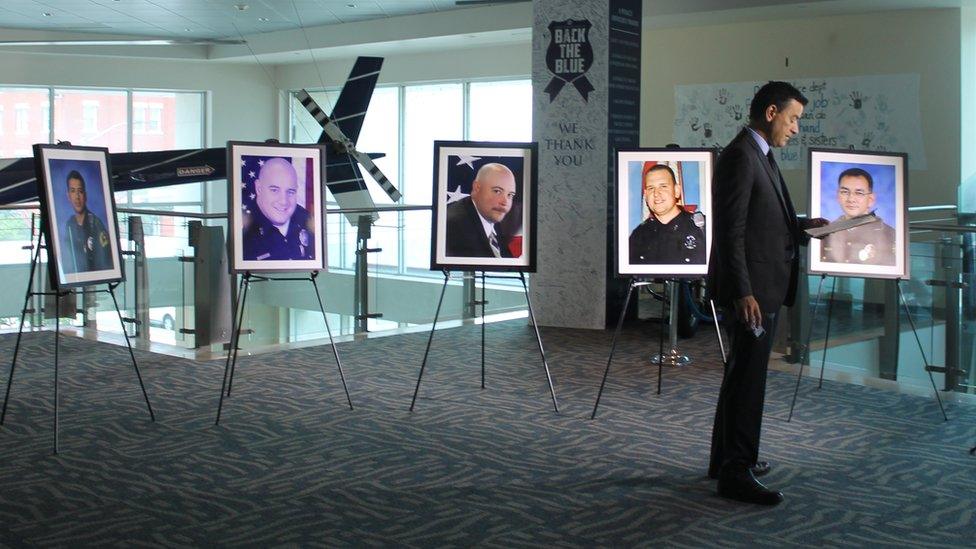
Portraits of the five fallen officers at Dallas police headquarters
"I'm doing [on 7 July] what the rest of the police department and what Parkland Hospital is doing - we're going to take a few minutes for ourselves and we're going to reflect and honour the memory of our colleagues that aren't with us anymore," he said. "And then we're going to do what we do everyday. We're going to come to work and do our jobs and protect this great city."
Eastman went on duty to help watch over the city-wide memorial held in front of Dallas' city hall. Hundreds poured into the grassy areas in front of the building to listen to state and local politicians express condolences and grief, pledges of loyalty to the men and women in blue, and for extra spending on police tactical gear. At exactly 8:58pm, when the shooting began a year earlier, the crowd held tiny blue lights aloft as bagpipers played Amazing Grace.
Although the deaths of the officers took place at a protest over the deaths of Castile and Sterling, few of those present drew a link from those deaths to the deaths of the officers.
"I guess my perspective was we hadn't had anything like that happen in Dallas, so why did we pay for other issues?" said police dispatcher Abigail Irizarry, who was on duty the night of the ambush. "Why us?"
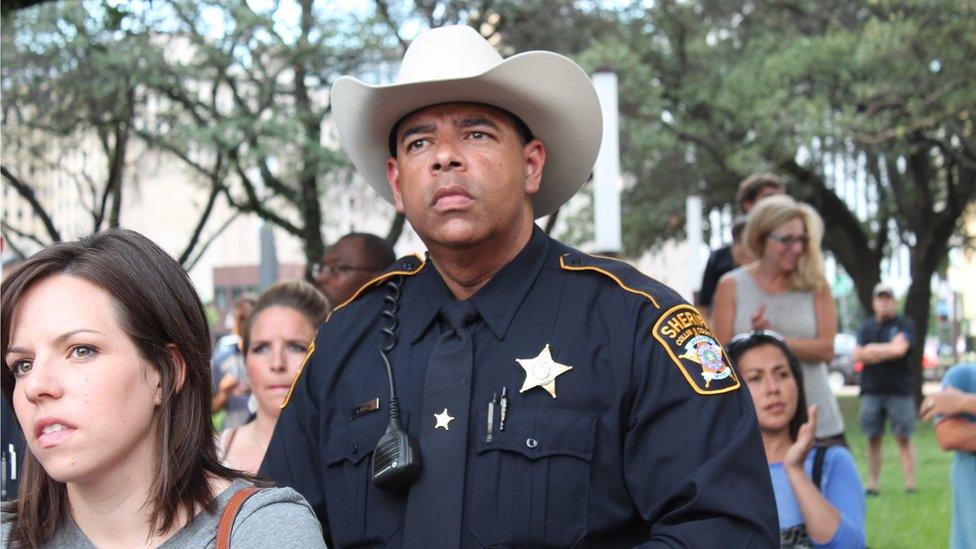
For Jose Vela, the contrast was even more stark. One year ago, he'd come to the demonstration as the leader of an organisation called "Cop Block" which filmed and scrutinized police behaviour. Vela said he was a block and a half away when the shots began.
"I saw the police literally run towards the bullets flying," he said.
Vela was so affected he completely reversed course. He resigned from Cop Block, started showing up to police stations in Dallas with an American flag, donating money to police causes, and instead of filming cops, filming civilians to try to be of assistance to law enforcement.
"Crime is going up. The police department is short 400 officers. They're tired, they're desperate," he said. "There will always be bad police, but overall, all police are good. They all have families, they're all human beings."
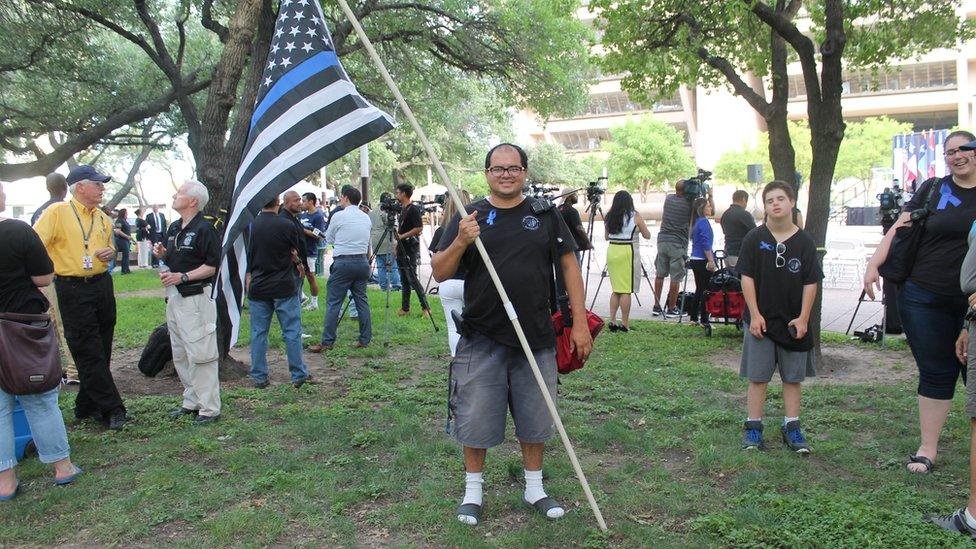
Jose Vela has gone from a protester of police to their number one fan
Opinions split from Baton Rouge to St Paul to Dallas on whether or not there is a way to connect the three days, and the seven deaths.
The Sterling family bristled at the thought that Alton somehow caused the deaths of the Dallas officers. Clarence Castile freely admitted he'd been too steeped in his own grief and effort to hold his family together to think about much about the other families.
The police community feels increasingly embattled after several ambush killings of officers over the past year including just last week, the death of a New York City police officer who was shot through the window of her cruiser by a mentally ill man.
But Shetamia Taylor quietly connected all these worlds. She was born in Louisiana, raised in Minnesota, and now lives in Texas - a set of facts that leads internet conspiracy theorists to accuse her of being a "crisis actor" and a hoaxer.
She went to the march a year ago to protest over police brutality, on behalf of her four black sons. She left wounded, but alive, thanks, she believes, to the bravery of an officer who died helping her.
Even before that day one year ago, her youngest son declared he wants to become a police officer, a decision she supports.
"I know there is false fear on both sides," she said on 7 July. "But being a black mother of four young black men at a time where race tensions are so high, to have these white officers so willingly risk their own lives for my black life? Come on now - everybody matters."